Sharing the Road – Traveling in the Age of Ridesharing Services

You’ve got your shopping list, a dentist appointment coming up and that hot date later. You get your things together and head out the door. But instead of driving yourself, you pull up a ridesharing app, request a ride and wait for a car that will take you all over town.
In recent years, ridesharing has shaken up the world of transportation − at least in metropolitan and urban areas. Uber and Lyft have become the hottest ways to get around, often leaving taxis in the dust.
We surveyed 2,048 people to find out their ridesharing experiences. Some of our questions included strange encounters and the possibility of dating drivers. Our survey-takers also shared their thoughts on deep conversations while in the backseat and weird situations they were glad to be done with. Read on to see what we discovered about adventures in the ridesharing economy.
Ridesharing Everyday
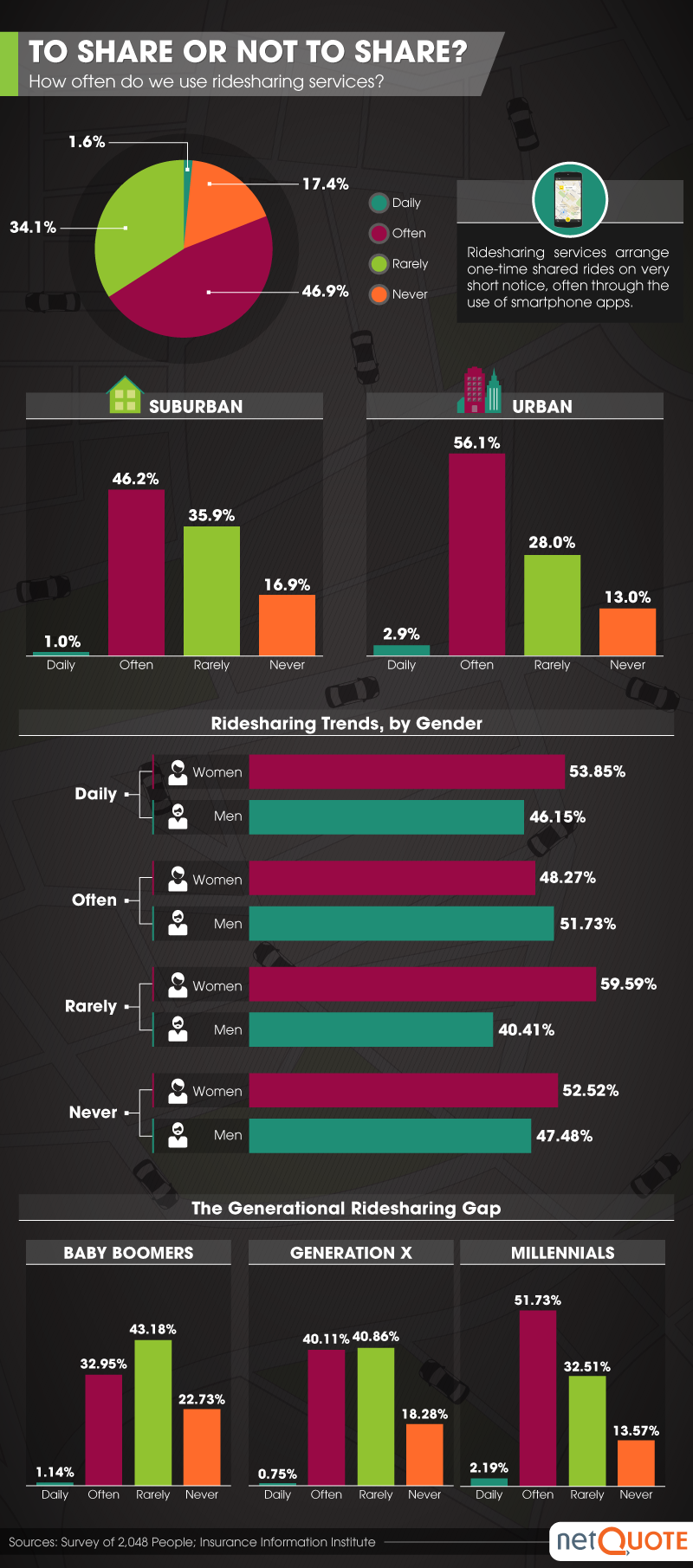
Getting around in the United States has changed during the last few decades. While we are still heavily dependent on owning our own vehicles, it may not be the most economical choice. The more than $8,000 per year to own a car just doesn’t add up. Their inefficient price structures make them expensive to purchase, yet inexpensive to drive. With alternative methods of travel − such as biking, walking, and public transportation − becoming more highly encouraged, ridesharing services are popping up to meet the demand for an on-call vehicle. These services, which used to be seen in urban areas only, are now spreading to most suburban neighborhoods.
Our survey participants use ridesharing services regularly. According to our findings, more than 46 percent of respondents living in a suburban area and 56 percent of respondents in an urban area use these services often. At the same time, over a quarter of urban participants said they rarely used a shared ride, while almost 36 percent of suburban respondents admitted the same.
Finally, nearly 17 percent of suburban and 13 percent of urban survey takers stated they have never used a ridesharing service.
Other trends include gender and generational differences. Female survey respondents stated that they use ridesharing services daily at a higher rate (54 percent) than male respondents (46 percent). But men said that they use the services “often” more than women. Those that claimed to use it rarely were mostly women (60 percent) compared with 40 percent of men.
Generationally speaking, Millennial survey participants reported using ridesharing services more often (52 percent) than Gen X (40 percent) or Baby Boomers (33 percent). Though that may not be surprising, it is interesting to note how often the older generations are using ridesharing services.
Ridesharing or Taxis?
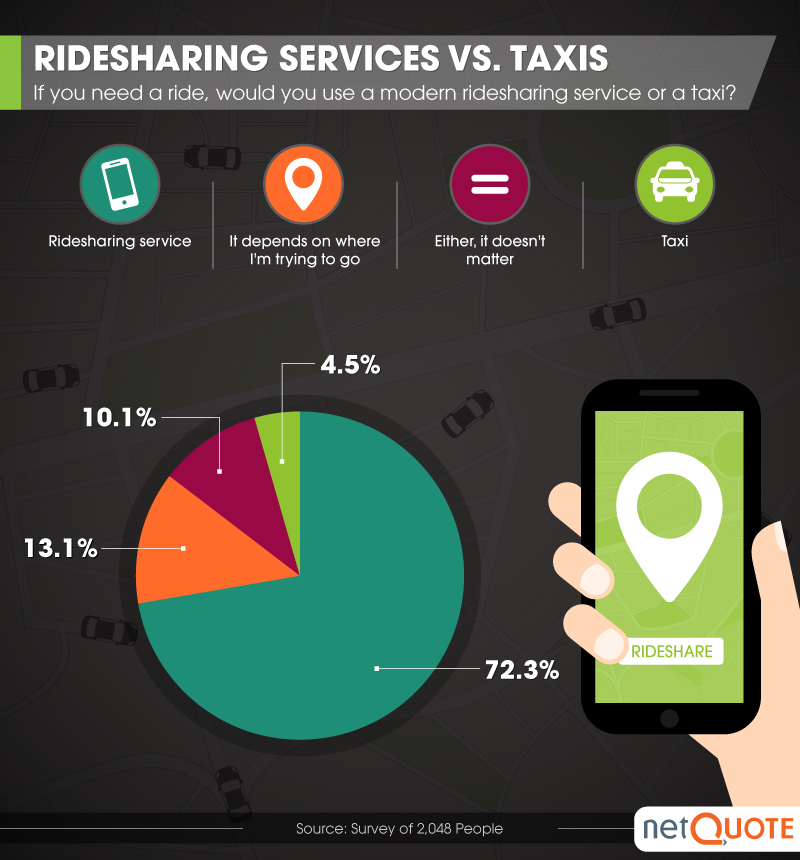
If you needed to get from point A to point B quickly, taxis were once the go-to choice. However, in recent years, services like Uber and Lyft have caused quite a stir – to the detriment of the taxi industry. Sometimes, this has landed ridesharing companies on a government’s officially banned list after taxi drivers protested.
Our results showed that ridesharing services are undeniably popular. People like the convenience of requesting a ride through an app and the fact that the ride will often be cheaper than a taxi. When it comes to using a ridesharing service or getting a taxi, an overwhelming majority (more than 72 percent) of our participants said they would use a ridesharing service. Only 13 percent said they would pick the service based on where they needed to go. Fewer than 5 percent prefer to hail a taxi.
The Benefits of Ridesharing
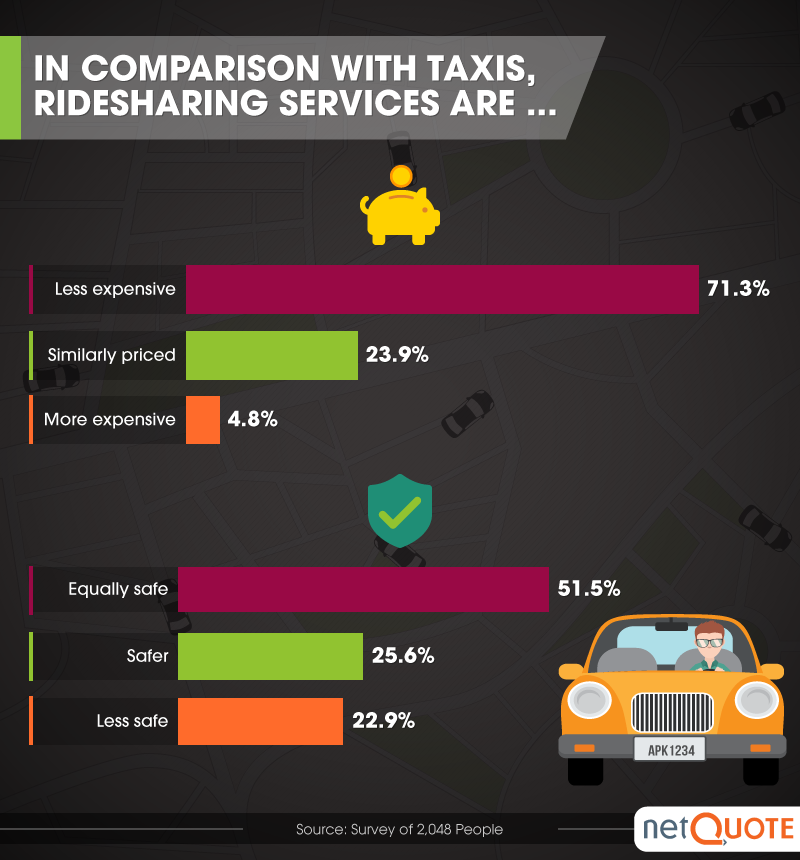
Regarding cost, more than 71 percent of survey-takers said that ridesharing services were less expensive than using a taxi. Almost 24 percent believed it was similarly priced, while about 5 percent considered ridesharing services to be more expensive.
As for safety, about 52 percent of respondents felt ridesharing services were as safe as taxis. Almost 26 percent considered them to be safer, and roughly 23 percent stated they were less safe.
Stop the Car!
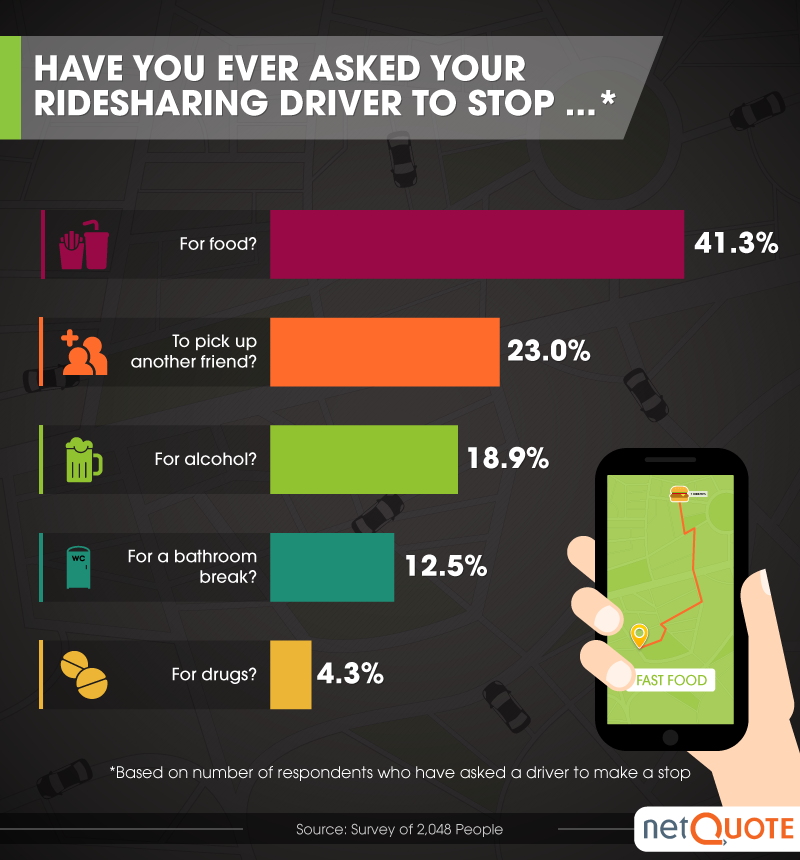
Ridesharing is the perfect blend of public transportation and car ownership. Cars are convenient for many reasons. One big bonus is the ability to stop on a whim. Forgot to pick up your dry cleaning yesterday? You can grab it on your way home from work. Public transportation is more affordable, but you also have less control over the stops and the time it takes to get around town. ridesharing is the winner when you need more autonomy with your ride.
We wondered if people often ask ridesharing drivers to make a stop during their ride. As it turns out, our respondents were not afraid to put on the brakes. Nearly 42 percent have asked their drivers to stop for food, while 23 percent have asked to pick up another friend. Stops for alcohol (about 19 percent), a bathroom break (almost 13 percent), and drugs (4.2 percent) also made the list. From the looks of it, ridesharing may be a great option if there are things you need to do along the way.
Ride-Dating
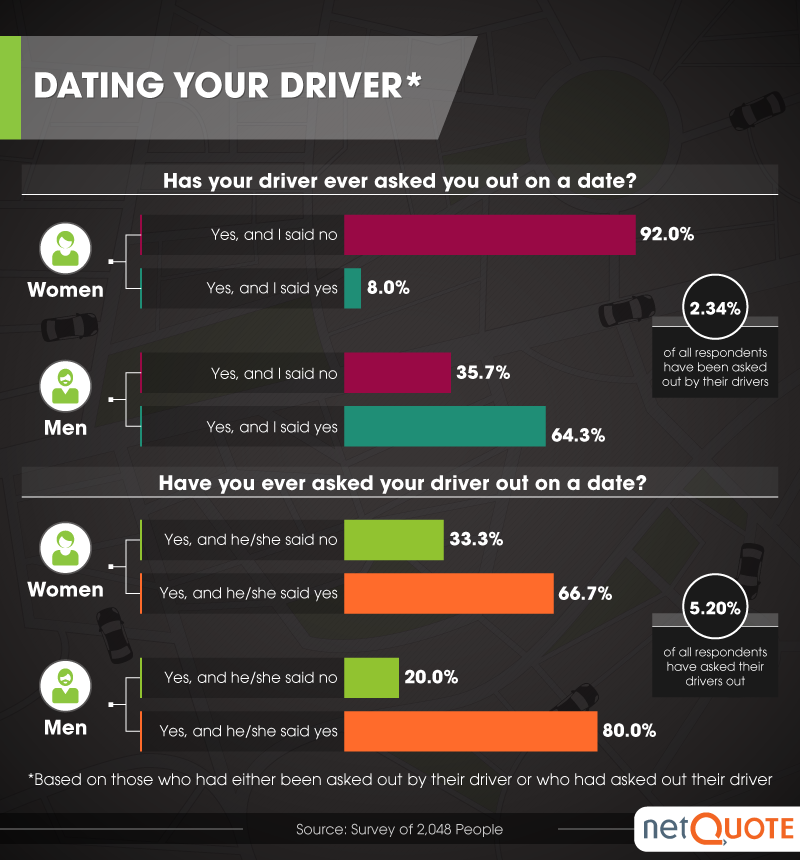
With the rising popularity of dating apps like Tinder, it’s no surprise that we’re bound to find our next romantic encounter digitally. It might be even more of an adventure to get a date while using a ridesharing service. In fact, one Uber driver has capitalized on this trend.
When asked about dating ridesharing drivers, our respondents were quick to dish out their pickup experiences. Ninety-two percent of women who were asked on a date by their driver declined, but over 64 percent of men who were asked actually responded yes.
When the tables were turned and survey takers asked their ridesharing drivers on a date, the responses were a lot more positive. In fact, nearly 67 percent of women who asked their drivers on a date received a “yes,” while 80 percent of men were just as lucky.
Cost to Ride
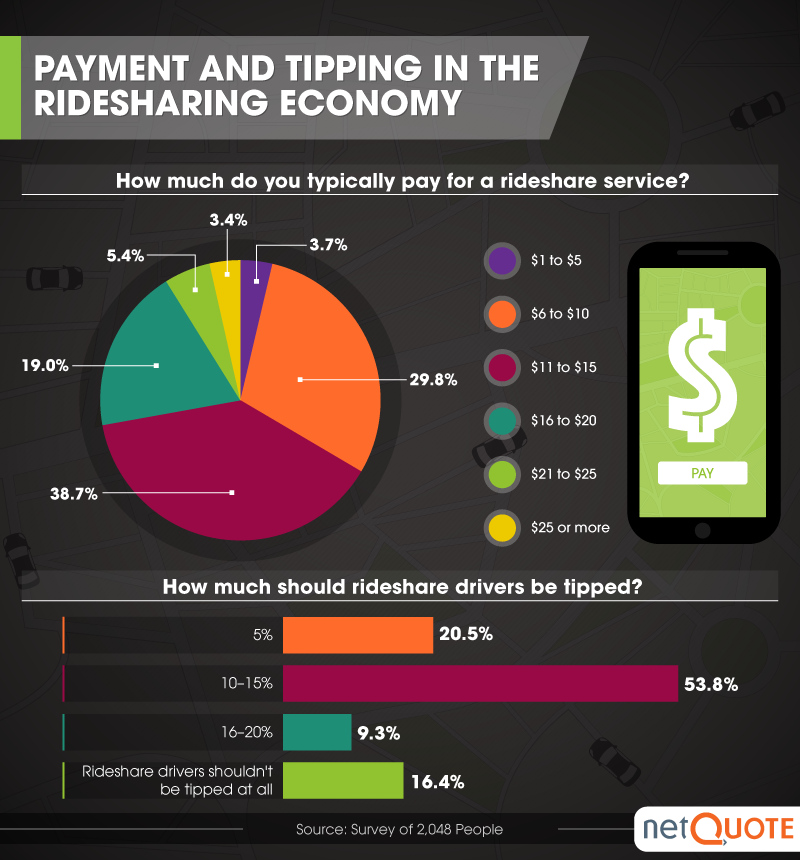
Ridesharing is a great option when you’re looking for convenience and affordability. Ridesharing can be a smart choice when you need some autonomy while not spending too much. There’s even an app to help you compare different modes of transportation against the cost of local ridesharing options. But is the new trend really that affordable?
We asked our participants to tell us about paying for their rideshare. What we found was that a majority of respondents (almost 39 percent) typically pay between $11 and $15 per ride, while nearly 30 percent pay between $6 and $10 per ride. Only around 4 percent said they pay $5 or less. The rest of the survey takers admitted to paying $16 or more.
Respondents also set us straight about how much they would be willing to tip for a ridesharing service. Almost 54 percent believe rideshare drivers should be tipped 10 to 15 percent, whereas fewer than 21 percent of participants believe a 5 percent tip is enough.
Sharing the Ride
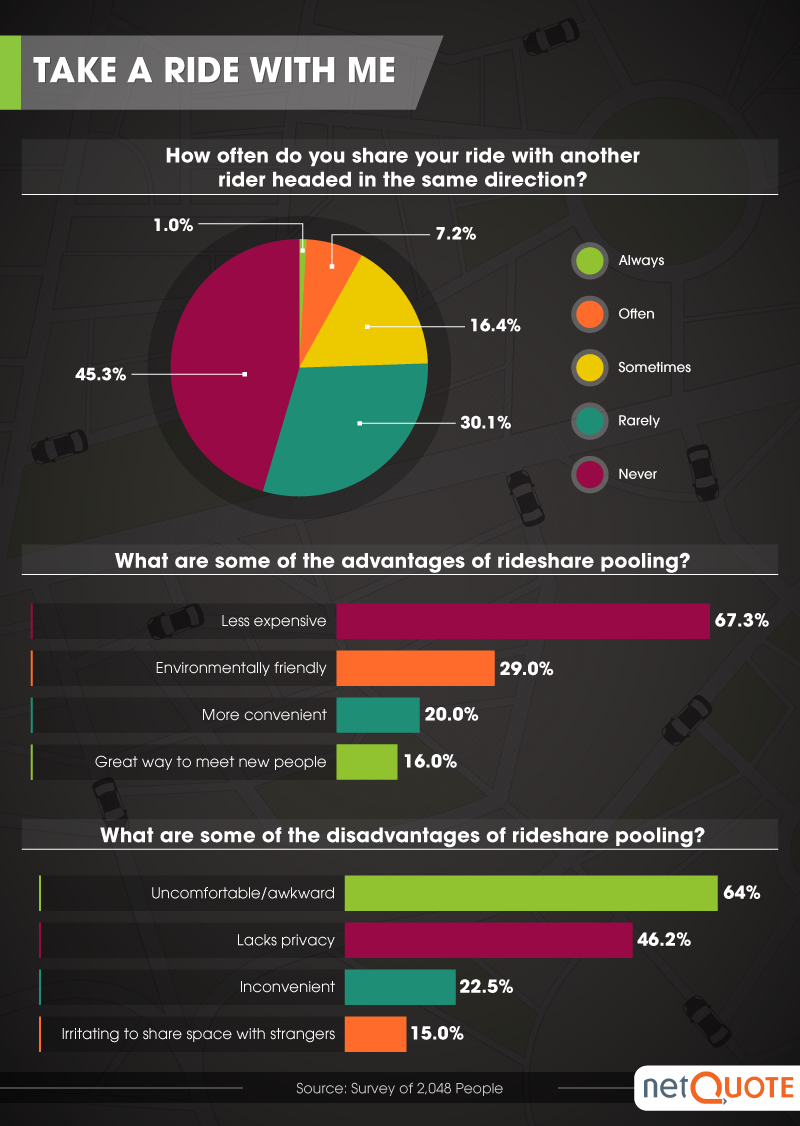
Rideshare pooling is different from ridesharing, but they can work well together. Carpooling used to be touted as a way to reduce overburdened freeways and greenhouse emissions. However, it’s been losing popularity over the past few decades. Sharing an Uber ride might be a great way to save money, but are you willing to ride with a stranger?
We asked our participants if they ever shared a ride with another passenger headed in the same direction. Nearly half of respondents said they have never shared a ride, while only 30 percent rarely have.
For those who have shared a ride, the biggest positive was that it was cheaper (67 percent). Many also thought that it was better for the environment (29 percent). The biggest negative was that it was sometimes awkward and uncomfortable to share a ride with a stranger (64 percent). It also took away personal privacy (46 percent).
Best and Worst Rides
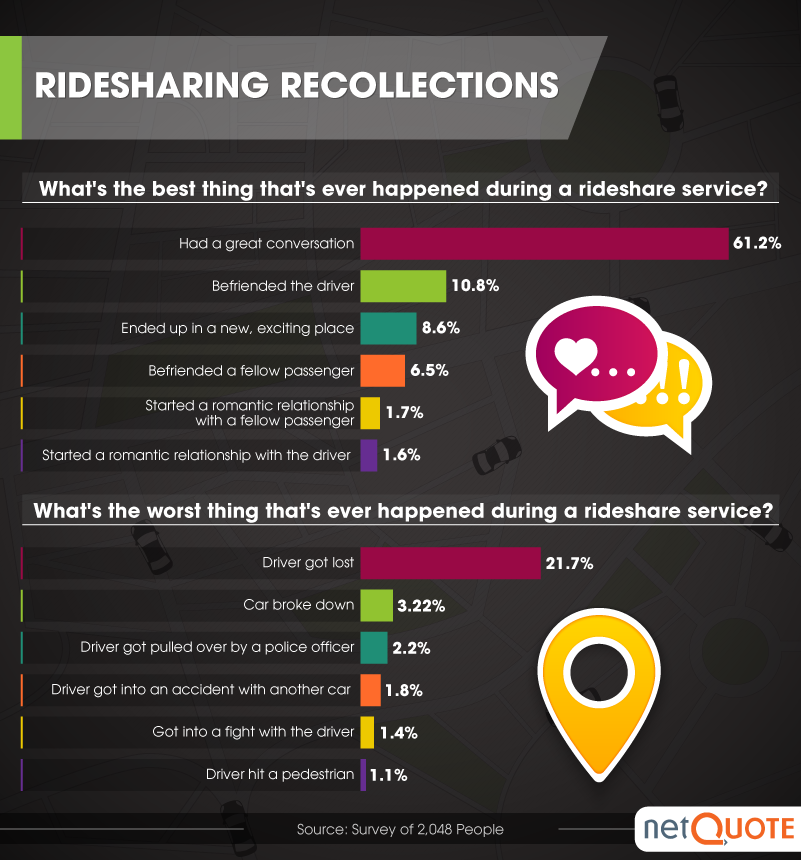
Ridesharing doesn’t come without risk. Of course, that can apply to any service where you’re climbing into a car with a stranger – taxis included. Sometimes, you might enjoy a friendly chat and make a new friend. Other times, you might be at risk for accidents or crooked drivers. Any ride could be the best or worst experience of your life. Thankfully, most of the time, it’s just about getting to your destination.
We asked our respondents to tell us about the best and worst things that have happened during their ridesharing experiences. The majority of respondents said they had a great conversation (61 percent). Other good experiences included the driver becoming a new friend (11 percent), going to a great place they had never been (9 percent), and making friends with a fellow passenger (7 percent).
When it came to bad experiences, the most common complaint was that the driver got lost (22 percent). Other negative experiences included the car breaking down (3 percent), the driver being pulled over by the police (2 percent), and the driver getting into an accident with another car (1 percent). Fortunately, the good experiences seem to outweigh the bad, which means you should be able to rest easy during your next ride.
Conclusion
When you head out on your next shopping trip or for a meeting, consider using a ridesharing service. If you’re in an urban area, you’ll probably have an easy time of it. There’s no doubt, though, that suburban areas will see an increasing number of Uber and Lyft drivers in the coming years. The great thing about ridesharing is the convenience of a car without the hassle of car ownership. You might find yourself enjoying a friendly conversation or landing a date if you hit it off with the driver. Even better, you might just make a new friend in your community.
Methodology
We surveyed 2,048 people in the United States on their opinions of and experiences with ridesharing services and taxis.
Sources
http://www.investopedia.com/articles/pf/08/cost-car-ownership.asp
http://www.planetizen.com/node/87067/smarter-taxi-and-ridesharing-policies
http://www.intransitionmag.org/spring2015/ride_hailing_in_suburbs.aspx
http://www.wsj.com/articles/uber-to-suspend-operations-in-budapest-1468412030
http://www.apta.com/mediacenter/ptbenefits/Pages/default.aspx
http://science.jrank.org/pages/4169/Mass-Transportation-Disadvantages-mass-transportation.html
http://www.vox.com/2016/9/8/12821412/uber-rideshare-dating-game-show
http://www.pennlive.com/midstate/index.ssf/2015/02/friendly_and_positive_experien.html
https://www.cnet.com/how-to/uber-lyft-ride-share-ridesharing/
Fair Use Statement: Don’t just share a ride − share our content (for noncommercial purposes only). All we ask is that our rideshare drivers (or authors of this page) are given the proper credit.
